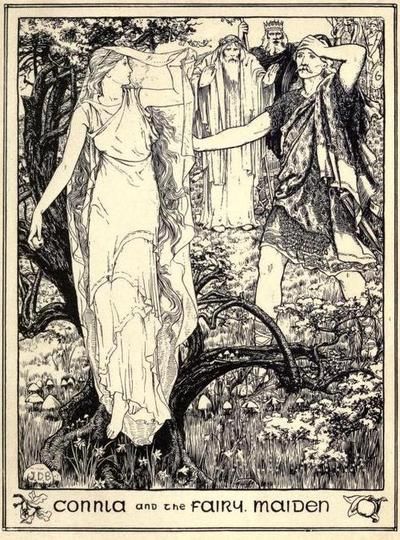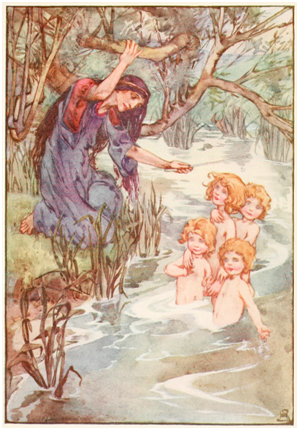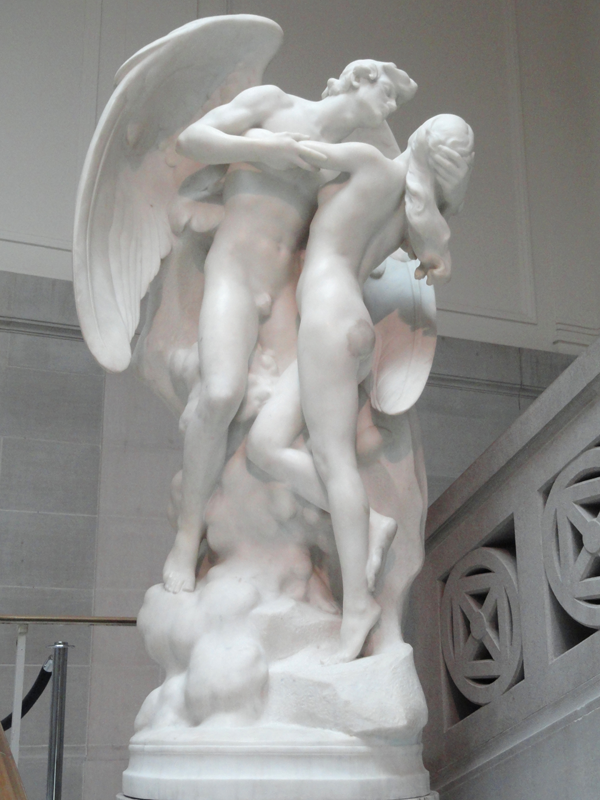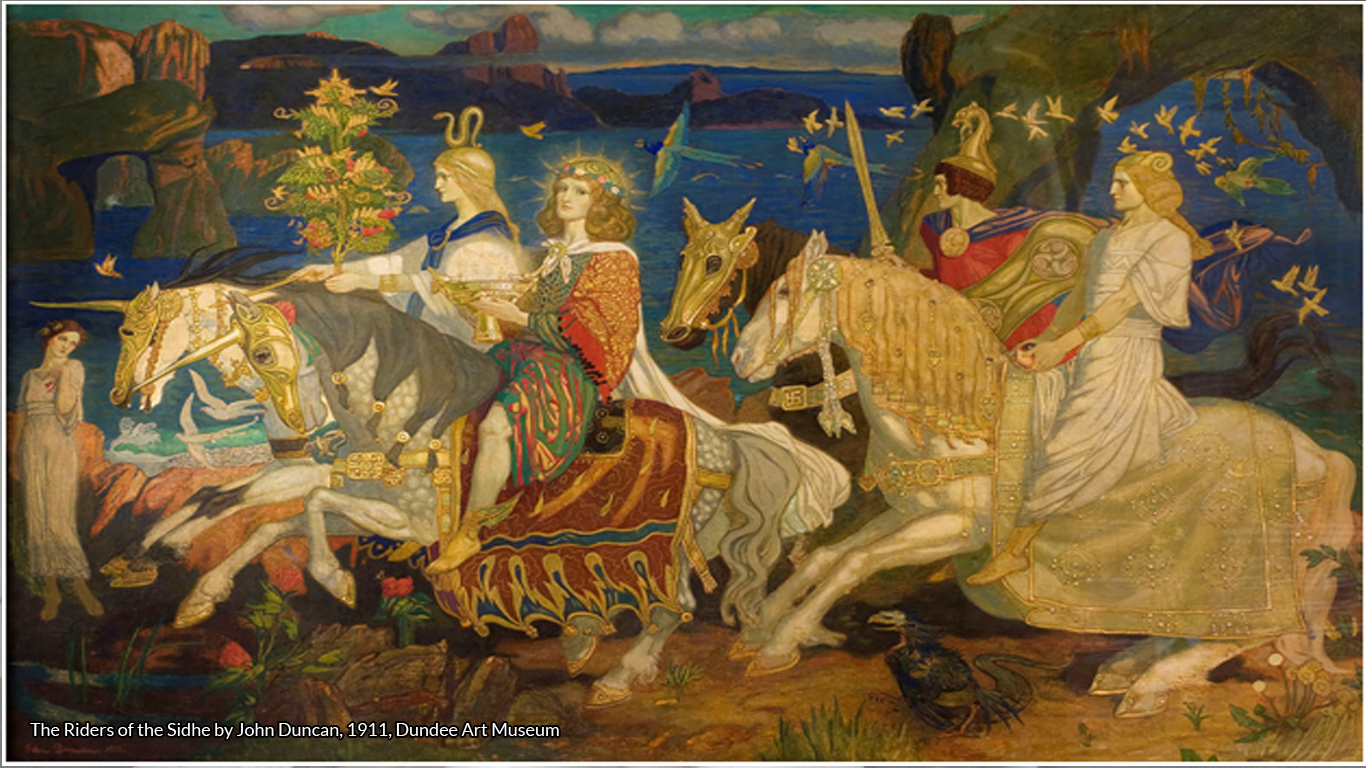“The ocean is not so strong as the waves of thy longing,” the fairy whispered to the man she desired as a human lover. Was she casting a spell on him, or helping him reconcile his feelings for an otherworldly being? The line comes from an early Celtic tale, Connla and the Fairy Maiden, and the story never answers that question; it leaves it to play in the reader’s mind.
Personally, I believe that the fairy was casting a spell, but what intrigues me more is the tale’s unchallenged premise that fairies could, and would, take humans as consorts. Are these the same beings as those from my childhood, dragonfly-size fairies like Tinker Bell? Clearly not, for in the ancient folklore fairies had trysts and procreated with humans.

This strain of old lore came to my attention when I was researching fairy history for a novel set in medieval Ireland. I learned that the original fairies — pre-Christianized and pre-Disneyfied — were tall, powerful, and amorous beings. The language of the fairy maiden is filled with desire:
“I love Connla, and now I call him away to the Plain of Pleasure, Moy Mell. Oh, come with me, Connla of the Fiery Hair, ruddy as the dawn with thy tawny skin. A fairy crown awaits thee to grace thy comely face and royal form.”
The Book of Invasions, an 11th century assemblage of chronicles that are old beyond history, tells how the fairies landed in Ireland and drove the Fomorians, fierce creatures themselves, into the sea to become merpeople. Back then, fairies were large and strong enough to fight in epic battles, ride full-size horses, and wield great swords. The Book of Invasions goes on to recount how, when humans arrived, Ireland was divided in two in order to maintain peace between the races. The humans were granted the surface of the land, while the fairies manifested in a hidden, parallel Ireland called the Middle Kingdom. Fairies could travel from one land to the other through magical doorways set in mounds.
However, this separation did not stop the Celts from becoming irresistibly drawn to the affectionate beings, and even having children with them. Returning to the tale of Connla and the Fairy Maiden, Connla cried out “a longing seizes me for the maiden,” and he ran away with her to the “Plain of Pleasure.”
It was not just the Irish, either. Throughout the centuries, scores of humans succumbed to the romantic allure of fairies. One of those unions can be witnessed in the history of the fairy flag of the Scottish MacLeod clan, a gift to their chieftain from his departing fairy lover, the mother of his hybrid son. Today the flag can be seen in Dunvegan Castle, and it is said to increase the chances of fertility as well as provide protection in battle.
Another illustrative tale is that of the strong-minded Welsh fairy princess, Rhiannon, the oldest written version of which appears in the 12th century Mabinogi. Rhiannon rejected the betrothal thrust on her by her fairy family and took a human named Pwyll as her consort, bearing him a son who was then stolen by a monster. Even though Rhiannon was accused of killing the hybrid boy, Pwyll stood by her, steadfast in his love, until the boy was found and returned.

In the strangely compelling age-old Celtic tale The Children of Lir, a fairy king and his human queen were deeply in love and had four beautiful children. Following his queen’s death, Lir eventually married another, but his new wife was so consumed with jealousy over Lir’s love for his children that she cursed them to live as swans.
“The doom will end when a king from the North weds a queen from the South; when a druid with a shaven crown comes over the seas; when you hear the sound of a little bell that rings for prayers.”
When Lir discovered his new wife’s treachery, she felt the wrath of a fairy curse:
“She is herself ensnared, and fierce winds drive her into all the restless places of the earth. She has lost her beauty and become terrible; she is a Demon of the Air, and must wander desolate to the end of time.”

Yet revenge did not soothe Lir’s broken heart. Nor could he lift the enchantment on his swan children, only bless them as they flew away:
“May all beautiful things grow henceforth more beautiful to you, and may the song you have be melody in the heart of whoever hears it. May your wings winnow joy for you out of the air, and your feet be glad in the waterways. My blessing be on you till the sea loses its saltiness and the trees forget to bud in springtime.”
Perhaps fairies have such passionate natures due to their parentage. One of the stranger fairy origin tales suggests that they are the offspring of angels so consumed by desire that they were willing to risk their place in heaven to possess mortal women. Interestingly, this lore also uncovers the source of fairies’ magical abilities.
The story begins in the first age of our world, and elements can be found not only in mythology but in the Zohar and two books from the Dead Sea Scrolls, Jubilees and Enoch. The story even lingers in an abbreviated form in Genesis 6:4 (English Standard Version):
“The Nephilim were on the earth in those days, and also afterward, when the sons of God [angels] came in to the daughters of man and they bore children to them.”

Driven to seduce the daughters of Adam and Eve, angels — all of whom were male — snuck out of heaven to infiltrate the human encampment east of Eden. Their hybrid children became a new breed of mysterious and magical beings. Bearing the magical bloodline of angels, fairies inherited a portion of the mystical abilities of their ancestors. With their gifts, they soon spread across the entire world, splitting into many clans.
Flush with the knowledge that ancient fairies were not diminutive in size, love, or ferocity, I felt prepared to tell their story. The resulting novel, The Last Days of Magic, is set in a medieval age when fairies still held sway in world events and interacted with humans in the royal courts, on the battlefields, and in the bedrooms.

Win a copy of The Last Days of Magic by Mark Tompkins
The wonderful folks over at Penguin Books have offered a copy of Mark’s amazing new novel along with a custom tarot deck for one lucky #FolkloreThursday newsletter subscribers this month!
Aisling, a goddess in human form, and her twin Anya, unite the Celts and the powerful faeries of the Middle Kingdom. But medieval Ireland is deeply divided. Jordan, the Vatican commander, is tasked with vanquishing otherworldly creatures from a disenchanted Europe. But increasingly he finds himself torn between duty and a desire to learn about this magic. As Kings and armies gather, Aisling and Jordan must come together to try and save the deeply divided county. Loyalties are tested, betrays sown; the coming war will have repercussions even into today’s world.
Sign up for the #FolkloreThursday newsletter to enter (valid May 2017; UK & ROI only).
The book can be purchased here.

